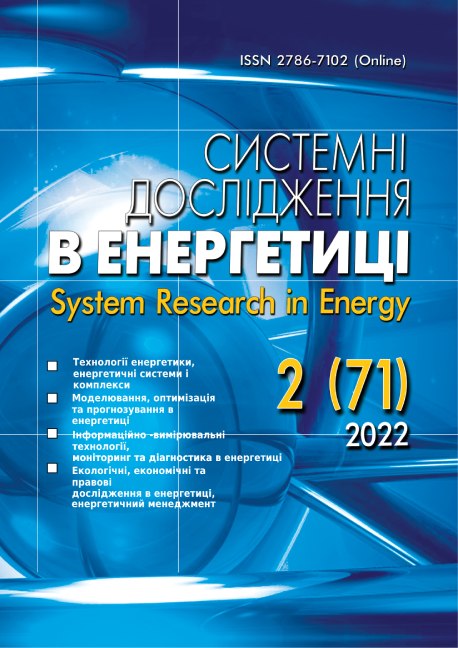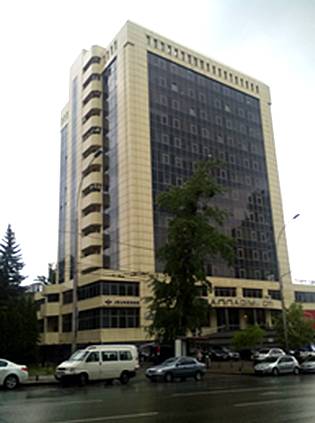 General Energy Institute of National Academy of Sciences of Ukraine celebrated 25 years since its foundation
General Energy Institute of National Academy of Sciences of Ukraine celebrated 25 years since its foundation
General Energy Institute of National Academy of Sciences of Ukraine (IZE of the National Academy of Sciences of Ukraine) is a center of fundamental and applied scientific research aimed at solving national strategic issues of energy development in Ukraine.
The activity of the Institute began in 1988, when by Resolution No. 138 of the Bureau of the Presidium of the Academy of Sciences of the Ukrainian SSR dated 04/07/1988 on the basis of the Department of Problems of Conversion and Use of Electricity of the Institute of Electrodynamics of the Academy of Sciences of the Ukrainian SSR, Departments of System Research in Energy and High-Temperature Energy Conversion of the Institute of Modeling Problems in Energy of the Academy of Sciences of the Ukrainian SSR and the Complex of Thermometry in Energy of the Institute of Technical Thermophysics of the Academy of Sciences of the Ukrainian SSR, the Institute of Energy Saving Problems of the Academy of Sciences of the Ukrainian SSR (IPE of the Academy of Sciences of the Ukrainian SSR) with a Special Design and Technology Bureau with experimental production was established.
Volodymyr Tonkal, a well-known scientist in the field of energy, energy saving and conversion technology, a corresponding member of the Academy of Sciences of the Ukrainian SSR, was elected the director of the IPE of the Academy of Sciences of the Ukrainian SSR.
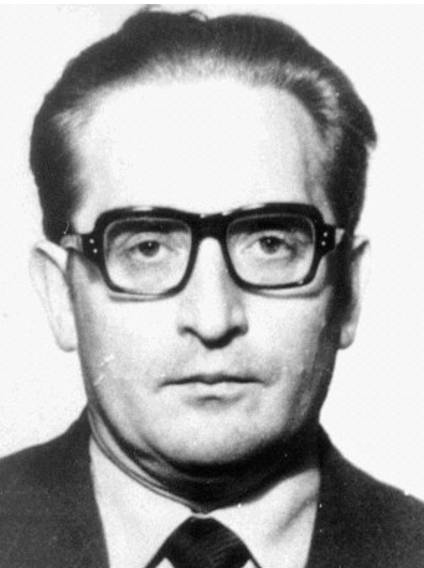
Director of IPE of the Academy of Sciences of the Ukrainian SSR, member-cor. Volodymyr Yukhimovych Tonkal, Academy of Sciences of the Ukrainian SSR
After the declaration of Ukraine's independence, the Institute of Energy Conservation Problems of the Academy of Sciences of the Ukrainian SSR became the Institute of Energy Conservation Problems of the National Academy of Sciences of Ukraine (IPE of the National Academy of Sciences of Ukraine).
Among the most significant results of the work of IPE of the National Academy of Sciences of Ukraine is the development of the Comprehensive State Energy Saving Program of Ukraine, which was put into effect by Resolution No. 148 of the Cabinet of Ministers of Ukraine dated 05.02.1997. The scientific director of the development of this important state document was at that time the corresponding member of the National Academy of Sciences of Ukraine .M. Kulyk, leading scientists of the IPE of the National Academy of Sciences of Ukraine were involved in the work.
After Ukraine declared its independence, its energy sector faced new challenges that required new approaches and solutions that were not limited to energy saving. In particular, the issue of long-term forecasting of the functioning and development of the country's energy sector and its industries, forecasting scientific and technological progress in the energy sector, and researching the problems of managing energy systems and complexes in the new economic, political, and international environment became acute. Ukraine had no scientific organization to address these problems in a comprehensive manner, not only within the National Academy of Sciences of Ukraine, but also among the country's sectoral institutions, as in the former Soviet Union they were solved exclusively at the level of the country's central government.
To address the totality of these problems, by the Resolution of the Presidium of the NAS of Ukraine of 26.02.1997 No. 83, the IEP of the NAS of Ukraine was reorganized into the Institute of General Energy of the NAS of Ukraine (IGE of the NAS of Ukraine). One of the important aspects of the new Institute's practical activities was to be the systematic development of scientifically based recommendations and proposals for state authorities on structural policy of energy development, regulatory problems of its functioning and development, and increasing the efficiency of fuel and energy resources.

Resolution on the establishment of General Energy Institute of the National Academy of Sciences of Ukraine
Corresponding Member of the National Academy of Sciences of Ukraine Mykhailo Mykolayovych Kulyk (since 2000, Academician of the National Academy of Sciences of Ukraine) was elected Director of the Institute of General Energy of the National Academy of Sciences of Ukraine, who headed the Institute until March 2022.
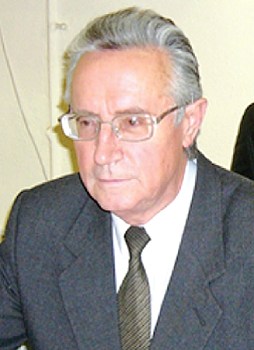
Academician of the National Academy of Sciences of Ukraine M.M. Kulyk is a leading Ukrainian scientist in the field of general energy, Doctor of Technical Sciences, Professor, author of more than 260 scientific papers, including 14 monographs. He is a laureate of the State Prize of Ukraine in Science and Technology (1999), a laureate of the S.O. Lebedev Prize of the National Academy of Sciences of Ukraine (1994) and the Khrushchev Prize of the National Academy of Sciences of Ukraine (2002), and an Honored Worker of Science and Technology of Ukraine (2003).
M.M. Kulyk is a leading scientist, in particular, in modeling of long-term forecasting and optimization of energy development in an inter-sectoral setting, optimization of the development of the country's electric power system, oil and gas and coal industries under conditions of rational nature management and ensuring energy security of the state. He is the developer of the theory of adaptive systems for automatic frequency and power control in integrated power systems, synthesized on the basis of passive regulators and large energy storage devices, whose performance is almost three times higher than that of traditional systems. He is fruitfully working on the problem of developing central models of inter-sectoral balance (V.V. Leontiev's model) for forecasting economic and energy processes at the national and global levels for the medium and long term, developing complex models for forecasting energy demand for the long term with increased accuracy. More than 20 PhDs have defended their theses under the supervision of M.M. Kulyk.
In accordance with the Order of the Presidium of the National Academy of Sciences of Ukraine No. 133 dated 22.02.2022, Academician of the National Academy of Sciences of Ukraine Vitalii Babak, a well-known scientist in Ukraine and abroad in the field of energy and information technology, in particular, monitoring and diagnostics of power systems and energy efficiency, was appointed Acting Director of the Institute of General Energy of the National Academy of Sciences of Ukraine effective 01.03.2022. He is one of the founders and leader of the scientific field of creating a new class of devices and systems for diagnosing energy facilities based on noise diagnostics and heat flow sensors.
According to the Resolution of the Presidium of the National Academy of Sciences of Ukraine No. 44 dated 07.02.2024, Academician of the National Academy of Sciences of Ukraine Vitalii Babak was appointed as Director of the Institute of General Energy of the National Academy of Sciences of Ukraine on February 07, 2024."
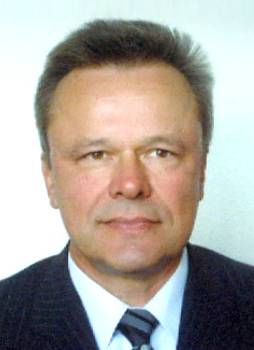
Director of GEI of National Academy of Sciences of Ukraine, Academician of the National Academy of Sciences of Ukraine Vitalii Babak
For all 25 years of its existence, the Institute has been at the forefront of national science, and its research is aimed at addressing national strategic issues of energy development. Leading researchers of the Institute have a broad outlook, which allows them to solve problems of energy development taking into account not only purely technical and technological factors, but also economic and environmental aspects of the development of both the energy sector and the country's economy as a whole, and to take into account global trends in energy development. This makes it possible to successfully solve general problems of balanced development of the energy complex in the long term, to develop forecast fuel and energy balances (including in the intersectoral setting), to formulate directions for improving energy efficiency in the production, processing and use of fuel and energy resources, to offer reasonable proposals for solving specific problems of the country's energy policy and fulfilling its and environmental obligations.
For many years, the Institute has been continuously carrying out research to create and improve methods and tools for studying the prospects for the development of the energy sector of Ukraine. At the same time, the growing uncertainty of future conditions for the development and functioning of the economy and energy sector of a particular country, caused by the globalization of the world economy, liberalization of markets for products, goods and services, including energy, internationalization of environmental requirements and restrictions, diversity of investment resources, and the growing impact of energy prices on the pace and direction of economic development, significantly complicates the forecasting of energy development and requires constant improvement of methods and means of conducting relevant research.
To solve these problems, the Institute's specialists, for the first time in Ukraine, have developed and are constantly improving systems of multi-level, mutually consistent, dynamic simulation and optimization models with stochastic parameters and integer variables that ensure the search for the optimal trajectory of development of the energy complex of Ukraine and its sectoral systems in the long term, taking into account environmental constraints and requirements of national legislation and Ukraine's international obligations.
The main functional blocks of the created system are:
- Forecasting the future demand (need) for fuel and energy resources, which is a key issue in forecasting the development of the country's energy complex, improving energy efficiency and energy saving These studies are conducted by the Energy Efficiency and Energy Consumption Optimization Department;
- forecasting the development of the electric power sector. The research is carried out by the Department for Optimization of the Fuel and Energy Complex Structure, the Department for Forecasting the Development and Management of the Electric Power Industry, and the Department for Forecasting the Development of Nuclear and Renewable Energy;
- forecasting the development of the coal industry and the oil and gas complex. These issues are dealt with by the Department for Optimization of Fuel Bases Development and, partially, by the Department for Optimization of the Fuel and Energy Complex Structure;
- forecasting the development of heat supply systems. These studies are carried out by the Fuel and Energy Complex Structure Optimization Department, the Energy Efficiency and Energy Consumption Optimization Department, and the Electric Power Industry Development and Management Forecasting Department;
- optimization of perspective product fuel and energy balances. The Energy Efficiency and Energy Consumption Optimization Department and the Fuel Base Development Optimization Department are responsible for solving this problem.
Using the created tools, the Institute completed a number of developments on behalf of central authorities. The most important development was the draft Energy Strategy of Ukraine for the period up to 2030, approved by the Cabinet of Ministers of Ukraine No. 145 of March 15, 2006. The Institute of General Energy of the National Academy of Sciences of Ukraine acted as the main developer of this document.
In 2011, the Institute carried out research and development on the adjustment of the Energy Strategy of Ukraine until 2030. In 2017, the Institute carried out research and developed conceptual approaches to the development of Ukraine's energy sector for the period up to 2040.
For many years, the Institute has been systematically conducting research on the creation of methodological and theoretical foundations, methods and tools for taking into account environmental factors in the study of the functioning and development of energy facilities and systems. The Institute's specialists participated in the development of the National Communication of Ukraine on Climate Change (first), and, at the request of the Ministry of Ecology and Natural Resources of Ukraine, the Institute developed the Inventory of Greenhouse Gas Emissions in the Energy Sector in Ukraine in 1991-1998. Since 2001, the Institute has been a leading scientific organization on the implementation of the UN Framework Convention on Climate Change, the Kyoto Protocol and the Paris Climate Agreement in Ukraine, actively participates in expert and analytical support of many documents, annually performs expert assessment of the National Inventories of Greenhouse Gas Emissions by Sources and Removal by Sinks in Ukraine.
One of the aspects of the Institute's practical activities is the systematic development and preparation of scientifically based recommendations and proposals for state authorities on structural policy of energy development, regulatory issues of its functioning and development, and improvement of energy and fuel and energy resources efficiency.
The results of the research conducted and currently being conducted at the Institute were and are used in the development of a number of important state documents on behalf of the Presidential Administration of Ukraine, committees of the Verkhovna Rada of Ukraine, the Cabinet of Ministers of Ukraine, the National Security and Defense Council of Ukraine, the Ministry of Energy of Ukraine, the Ministry of Environmental Protection and Natural Resources of Ukraine, the Ministry of Economy of Ukraine, the State Agency for Energy Efficiency and Energy Saving of Ukraine, and the Presidium of the National Academy of Sciences of Ukraine.
Thus, on behalf of the State Committee on Energy Efficiency and Energy Saving of Ukraine, the Institute developed the Concept of the State Program for Improving Energy Efficiency and Energy Saving of Ukraine (2007), which is aimed at solving the problems of energy efficiency of the Ukrainian economy and increasing attention to solving the problems of high energy intensity of the country's economy. The development of such a program was relevant, as the Comprehensive State Energy Saving Program of Ukraine, which was in effect at the time of the Concept development, was due to expire in 2010. The Institute's experts prepared materials for the National Report on the Implementation of the State Energy Efficiency Policy for 2010-2011 (2012).
Since 2000, the annual addresses of the President of Ukraine to the Verkhovna Rada of Ukraine have included thematic reports. The content of such reports and the composition of the working groups for their development were determined by the relevant orders of the Presidential Administration. In accordance with such orders, the Institute of General Energy of the National Academy of Sciences of Ukraine participated in the development of thematic reports on energy issues as part of the Addresses of the President of Ukraine to the Verkhovna Rada of Ukraine for 2000, 2003 and 2005. The Institute's specialists took part in the preparation of the thematic report "Energy Supply of the Ukrainian Economy and Energy Saving", which was included in the Address of the President of Ukraine to the Verkhovna Rada of Ukraine "On the Internal and External Situation of Ukraine in 2000", the thematic report "Energy Markets of Ukraine: Directions of Development and Improvement", which was included in the Address of the President of Ukraine to the Verkhovna Rada of Ukraine "On the Internal and External Situation of Ukraine in 2003", the section of the thematic report "Ensuring Energy Security of Ukraine", which was published in 2005.
In recent years, the Institute's scientists have prepared a number of analytical notes on the current state and projected directions of development of the energy sector of Ukraine on behalf of the highest governing bodies of the state.
As of the beginning of 2022, the Institute had 6 research departments: Department for Optimization of the Fuel and Energy Complex Structure; Department for Energy Efficiency and Optimization of Energy Consumption; Department for Optimization of Fuel Bases Development; Department for Forecasting the Development and Management of Electric Power Industry; Department for Forecasting the Development of Nuclear and Renewable Energy; and Department for Monitoring and Diagnostics of Energy Facilities, which was transferred to the Institute in January 2022. In October 2022, due to personnel changes that took place at the Institute and
taking into account the adjusted scientific areas of research of the Institute, approved by the Resolution of the Presidium of the National Academy of Sciences of Ukraine No. 74 dated 23.02.2022, four new scientific departments were formed by reorganizing the existing six scientific departments:
Department for Forecasting the Development of the Electricity Sector
Department for Transformation of the Fuel and Energy Complex Structure
Department for Forecasting Energy Efficiency and Prospective Fuel and Energy Balances
Department of Monitoring and Diagnostics of Energy Facilities.
The Institute also established the Department of Scientific and Organizational Work on the basis of the Scientific Information and Documentation Service.
As of 01.01.2023, the Institute has 97 employees, including 3 academicians of the National Academy of Sciences of Ukraine (Kulyk M.M., Khalatov A.A.,Babak V.P.), 2 corresponding members of the National Academy of Sciences of Ukraine
(, Novoseltsev O.V., Fialko N.M.), 13 Doctors and 35 Candidates of Sciences.
The results of the research carried out by the Institute were used by the specialists of the National Energy Campaign "Ukrenergo" in the preparation of Reports on the assessment of the adequacy (sufficiency) of generating capacities to cover the projected demand for electricity and ensure the necessary reserve.
The Institute has formed and successfully operates a scientific school of long-term energy and economic forecasting of the energy complex development, system analysis of energy efficiency and energy saving (founder and scientific director - Academician of the National Academy of Sciences of Ukraine M.M. Kulyk). Based on the research of this school, scientific foundations, mathematical tools, models and methods of long-term forecasting of the country's economy's need for fuel and energy resources, formation of optimal fuel and energy balances, optimization of the development of the country's energy complex as a whole and its sectoral systems (coal industry, electricity, nuclear power, oil and gas complexes, heat supply systems), development of regional energy systems, unconventional and renewable energy sources were created.
The Institute also has a scientific school of technical diagnostics of energy systems and information and measurement technologies (founder and scientific director - Academician of the National Academy of Sciences of Ukraine V.P. Babak). Based on the research of this school, scientific foundations and hardware and software for diagnostics of energy facilities based on noise diagnostics and heat flow sensors were created.
The Institute has a doctoral program, a postgraduate program and a specialized academic council for awarding the degree of Doctor of Science.
From 1999 to June 2022, the Institute published a collection of scientific papers "Problems of Common Energy". In 2022, the National Academy of Sciences of Ukraine and the Institute of General Energy of the National Academy of Sciences of Ukraine founded the scientific journal Systemic Research in Energy on the basis of the scientific collection "Problems of General Energy", which publishes scientific, analytical and research works of Ukrainian and foreign specialists, which present the results of their research aimed at solving fundamental and applied problems of development and functioning of the energy complex of Ukraine and other countries.
The works of the Institute's scientists were awarded the State Prize of Ukraine in Science and Technology, S.O. Lebedev, V.M. Khrushchev, G.F. Proskura, and V.I. Tolubinsky Prizes of the National Academy of Sciences of Ukraine.
The Institute is constantly involved in the implementation of applied research of the Committee on System Analysis under the Presidium of the National Academy of Sciences of Ukraine, which is aimed at solving fundamental problems of the national socio-economic sphere and ensuring its sustainable development.
The Institute actively develops international scientific cooperation in the field of system research in the energy sector. Since 2000 and up to now, the Institute has been carrying out joint fundamental and applied research with IIASA on a regular basis, in particular, the Institute's specialists are involved in research on the projects "Advanced System Analysis", "Environmentally Compatible Systems" and others.



